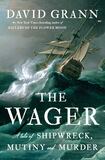
As the storm-battered man-of-war HMS Wager foundered near the remote southern tip of Patagonia in 1741, John Byron thought he glimpsed salvation – peering through the rain and mist, he spotted an island. “This was a great and merciful deliverance from immediate destruction,” recalled the teenaged midshipman, grandfather of the poet Lord Byron. “But then we had wet, cold, and hunger to struggle with, and no visible remedy against any of these evils.”
How the marooned ship’s company battled these evils – and their most dangerous adversaries, each other – is the harrowing tale of mutiny, treachery and survival told in The Wager. Bestselling author David Grann, a staff writer for The New Yorker, is a master storyteller and delivers a gripping, vivid, can’t-put-it-down read.
A toxic blend of greed, hubris and imperial ambition sent Byron and his shipmates on a voyage around treacherous Cape Horn in pursuit of Spanish treasure ships. Grann recreates life in the “wooden world” of a square-rigged royal navy ship in rich detail.
The admiralty resorted to kidnapping sailors and commandeering invalids from hospital beds to assemble crews. Samuel Johnson likened shipboard life to “being in jail, with the chance of being drowned,” but this was just one hazard. Typhus, scurvy, storms, and shipwrecks proved more deadly than any Spanish adversary. Of the 250 men and boys on board when the ship sailed, only 145 made it ashore.
Family fallouts: ‘I can’t describe the heartache of not having a relationship with my sister’
Zach Bryan in Dublin review: Gen Z’s Garth Brooks puts on a charming – and lengthy – show
How the death of an ‘old boy from Ireland’ in London-Irish suburb sparked a misguided viral appeal
As an Irish person in Australia there is one question I’m always asked
The desolate island offered little food or shelter. Dozens perished. Naval discipline disintegrated into menacing factions before most of the men mutinied. They set off in small, makeshift boats and, incredibly, almost 30 survived a 3,000-mile voyage to Brazil. Captain David Cheap, who had killed a rebellious crewman and ordered others brutally flogged, was left behind with a handful of loyalists. A few, including Byron and Cheap, made it back to England with remarkable survival tales of their own. The court-martial that should have determined who would hang for murder or mutiny was a whitewash. The nation’s reputation trumped justice.
The ship was named for an admiral, Sir Charles Wager, and the gesture was apt: the marooned crew gambled with their lives as they chose loyalty or betrayal, duty or survival, honour or disgrace. Readers looking for engaging, immersive history, however, can make a safe bet on The Wager.
Dean Jobb, author of The Case of the Murderous Dr. Cream: The Hunt for a Victorian Era Serial Killer (Algonquin Books), teaches nonfiction writing at the University of King’s College in Halifax, Nova Scotia














